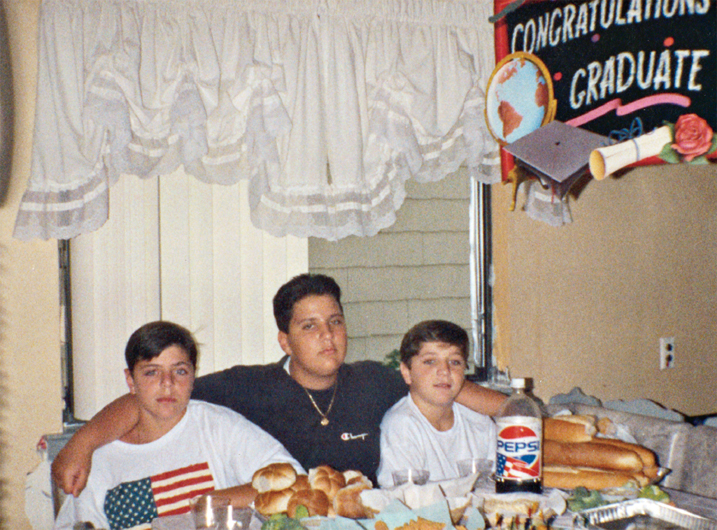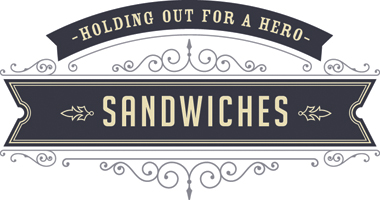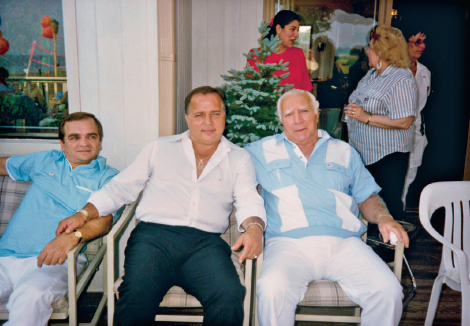Sal, Fran, and Sal’s brother Dominick
3.
You could say that sandwiches are in our blood. It all started with our grandpa Dominick Casale, who started sellin’ heros outta his car. He was working as a longshoreman, so he figured he could make a little extra money sellin’ sandwiches. Our grandmother would cook the sandwiches in the house—potatoes and eggs, eggplant, meatball, nothing too expensive to make—then they’d wrap ’em up in waxed paper and sell them right outta the trunk to the dockworkers. They weren’t sellin’ ’em for more than 50 cents a pop—it was the thirties, after all—but he knew there was money to be made in sandwiches.
In 1961, he opened Chubby Mary’s in downtown Brooklyn with our uncle Tommy. Back then, if you were walkin’ down Court Street with a hero in your hand and peppers and onions hanging out of it, you can bet you got it at Chubby Mary’s. Our grandfather was still workin’ down at the piers, though, so that restaurant was short-lived—but there was no gettin’ outta the business for our family. You see, our grandfather opened the shop so his sons—our uncles Tommy, Gregory, and Pudgie—could carry it on. Well, Tommy hated working in the business. He joined the army, he hated it so much! And Pudgie moved down to Miami and opened a big restaurant there—Casale’s Alley. He called it that because you had to drive to the back of the lot to get to the entrance. The best part? They shared parking with the Playboy Club next door. Our moms, who went down there to help their brother open the place, would watch the Bunnies smoke cigarettes during their breaks, when they weren’t busy preppin’ hundreds of glasses of shrimp cocktails for dinner service.
But our uncle Gregory, he understood the power of the sandwich. And let us tell you somethin’: It didn’t get much better than Uncle Greg. We remember, clear as day, Uncle Greg sittin’ outside one of his jewelry shops, holdin’ up one of those big mirrors in front of his face to get a suntan, with a big beautiful chain and a big beautiful watch and that beautiful ’66 ’Vette parked right there. He had an Olympic-size pool in his house in Todt Hill (the Bel Air of Staten Island) and for his twenty-fifth wedding anniversary, he took twenty-five people to Vegas. To us, he was the epitome of cool.
He’d done well in the jewelry business, so when Chubby Mary’s closed, he figured he’d open a few restaurants too. He opened three sandwich shops—all called Greg’s Heros—one on Hamilton Avenue, one on Clinton Street, and the third on Van Brunt Street. They did some heros, some hot plates, and a whole lot of rice puddin’. But it wasn’t Uncle Greg who made those places magic—it was the ladies. Greg mighta been the one to start the business, but it was his wife, Loulou, her twin sister, Gilda, and all their friends who made Greg’s run like it did.
Every morning, our aunt Loulou and Gilda—who lived with Loulou and Greg because she was widowed young—would wake up and drive to downtown Brooklyn to open one of the shops at five a.m. Now, this was Red Hook back in the day—not exactly a nice neighborhood. But it was a real workingman’s place. Every morning, all the factory workers and truck drivers and policemen and scrapyard guys—they all came in to work. And they needed somewhere to eat. And they especially needed somewhere to eat where all the ladies were pretty peroxide blondes who wore their hair all teased up with the big earrings and the makeup and the nails and the little aprons and all that. Sal’s mom still remembers how every night the girls would call each other to see which outfit they were all gonna wear the next day. But like we said, those ladies worked. These guys would come in and they would need to eat fast. Loulou and her crew would move three thousand sandwiches in the span of two hours. They had the 85-cent Special, which was their biggest seller—ham, cheese, lettuce, tomato, and mayo. It was big, too, like twelve inches, and it meant they’d go through something like three cases of ham and two cases of cheese a day. They’d have to pre-slice the cold cuts the night before because they’d be so busy pumpin’ out the sandwiches during the lunch rush. Sal’s mom swears that’s how she knocked her shoulder out. Then they’d slice up all the pies, stick a fork in each slice, and wrap ’em up so people could just grab one on the way out. In the afternoon, they’d get another rush of people who had a fifteen-minute break. The guys from the paint factory and the mattress factory would send the same runner with the same exact order every day. It got to the point where the guy on the grill would start gettin’ eggs on the flattop whenever he saw one of them comin’ over. Then the girls would line up the coffee cups and mark them—light and sweet, black, etc.—so he could get back in time for the workers to enjoy the rest of their break. And every afternoon at three p.m., they’d close up and head home, because after four p.m., you didn’t want to be in that neighborhood anymore. And for thirty years, Loulou, Gilda, and those ladies ran Greg’s.
Uncle Tommy, Uncle Gregory, and Grandpa Dominick
So for us, sandwiches have always been a way of life. Plus, heros were always a good way of gettin’ rid of leftovers. Eggplant, ham, turkey, chicken—whatever we had. And that was all right, because just about anything got better when it was tucked between two slices of fresh Cangiano’s bread. Some of our fondest memories are of packin’ up some heros and driving to the beach in our friend Jared’s mother’s Riviera. The sand would get into the sandwiches, but it was kinda nice how it added a little crunch. And then there was hanging out on our grandfather’s boat all day and just attacking the cooler when it was lunchtime. We’d be starvin’ from bein’ out on the water so long and couldn’t wait to tear into the heros he had made outta last night’s dinner. There wasn’t a late-night snack or school lunch or hangover that couldn’t be cured with a sandwich. As Sal once said, “You could feed a whole family with a loafa bread.”


